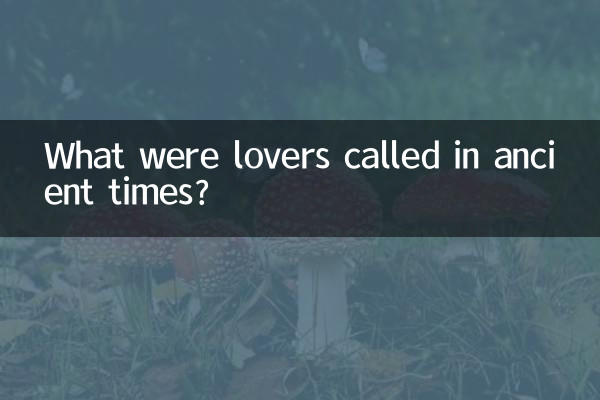What were lovers called in ancient times: Looking at ancient love culture from their titles
In modern society, we often use the word "couple" to refer to two people who are in love, but in ancient times, the names for lovers varied depending on the times and cultures. This article will combine the hot topics and hot content on the Internet in the past 10 days to explore the names of ancient lovers and the cultural connotations behind them.
1. Common titles for ancient couples

In ancient times, the names for lovers were rich and varied, including official terms and folk slang. Here are some common titles for ancient couples:
| title | dynasty | meaning |
|---|---|---|
| Husband and wife | Pre-Qin to Ming and Qing Dynasties | Refers to a couple, especially a couple with a deep relationship |
| Luanfeng | Han and Tang Dynasties | A metaphor for a loving couple, derived from the mythical bird |
| biwingbird | Tang and Song Dynasties | In the legend, two birds with one eye and one wing represent a loving couple. |
| Lian Lizhi | Ming and Qing Dynasties | The branches of two trees grow together, symbolizing inseparable love. |
| Biren | Wei and Jin | Refers to a loving couple with both talent and beauty |
2. The cultural connotation of ancient couple’s titles
The titles of ancient lovers not only describe the relationship, but also contain rich cultural connotations:
1.Use of natural imagery: Many titles such as "Luanfeng", "Biyiniao" and "Lianlizhi" are borrowed from pairs of things in nature to express good wishes for love.
2.The influence of Confucian ethics: For example, the word "husband and wife" emphasizes the solemnity and responsibility of the relationship between husband and wife, reflecting the Confucian norms on marriage.
3.sublimation of literature and art: Many titles come from poems and songs, such as "Bi Ren" from "Shi Shuo Xin Yu", which reflects the literati's aesthetic pursuit of love.
3. Popular love topics on the Internet in the past 10 days
Combined with recent Internet hot spots, we find that people’s attention to ancient love culture continues to increase:
| hot topics | platform | Discussion popularity |
|---|---|---|
| Ancient Valentine's Day Customs | Reading volume: 50 million+ | |
| love in ancient poetry | Tik Tok | Topic views reached 200 million+ |
| Revival of traditional wedding customs | little red book | Number of notes: 100,000+ |
| Couple photos in Hanfu | Station B | Related videos have been viewed over 30 million times |
4. Comparison of the titles of couples in ancient and modern times
By comparing the titles of couples in ancient and modern times, we can find:
1.simplification of title: In modern times, concise words such as "couple" and "object" are often used, while ancient titles are more literary.
2.changes in connotation: Modern titles emphasize equality, while ancient titles often reflect the idea that men are superior to women.
3.Differences in usage scenarios: Ancient titles are mostly used in formal occasions, while modern titles are suitable for various contexts.
5. Modern application of ancient couple’s titles
In recent years, with the rise of national trends, many ancient names for lovers have been rediscovered and applied to modern life:
1.wedding industry: Many wedding companies use "Luan Feng He Ming" and "Lian Lizhi" as themes.
2.Cultural and creative products: Cultural and creative products inspired by the titles of ancient couples are loved by young people.
3.Internet slang: Some ancient titles have been given new meanings and become Internet buzzwords.
Conclusion
From "husband and wife" to "couple", the change of titles reflects the changes in the concept of love. Understanding these ancient couple titles can not only increase our cultural knowledge, but also help us understand the Chinese people's view of love that has been passed down for thousands of years. Today, with the revival of the national trend, these beautiful ancient titles are taking on new vitality.
(The full text is about 850 words in total)

check the details

check the details